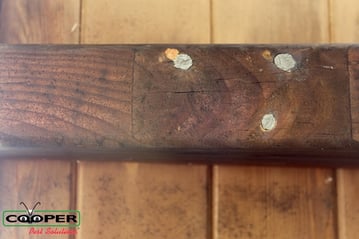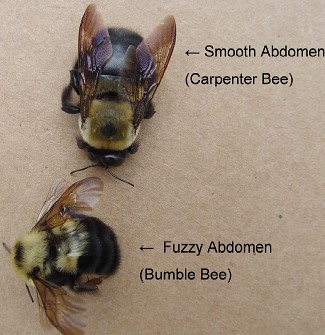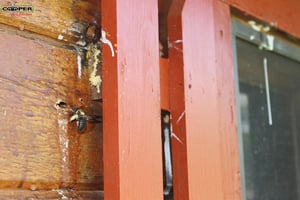How to Get Rid of Carpenter Bees
Carpenter bees are responsible for the perfectly round holes drilled into the fascia boards and eaves of your home, as well as porches, decks, and wooden playground equipment. Their size can be intimidating and comparable to a bumble bee, which can be frightening if you don't know what you are looking at. As a homeowner, you should be informed about the dangers are concerning the drilling of carpenter bee holes. Are you seeing carpenter bee damage or carpenter bee activity at your home? Or maybe you want to learn more about how carpenter bee services work. Our library of carpenter bee information will answer your questions.
Carpenter Bee Library Shortcuts
Carpenter Bees vs. Bumble Bees. What's the difference?
What's all the buzz about carpenter bees?
How much does it cost to get rid of carpenter bees?
Carpenter Bee Identification
These bees look like large bumble bees, but unlike bumble bees they have a shiny black abdomen. Carpenter bees also have distinctive flight patterns and are often seen diving and darting about and "chasing" each other in flight. They are solitary bees that make nests by chewing perfectly round tunnels into the wood where they lay 6-8 eggs. Many times there will be a brownish stain on the wood directly beneath their nests. These nests are commonly found along the trim of the roof-line, but they can be found in other places around the house as well. Even though each nest is individual many females will often make their nests in the same general area, and will return every year.
Generally, they construct their nests in fascia or in trees. Carpenter bees are simply looking for a place to create their nests. While they prefer natural softwoods that are untreated and unpainted, they can (and will) still nest in the wood used to build and side your house, deck, play set, etc.
If you see a number of large bees hovering near the eaves of the house or drilling in wood, you have carpenter bees
Carpenter Bee Control Tactics
Residual Liquid Treatment for Carpenter Bees
- If you currently have carpenter bees, your pest control technician will spray the liquid treatment in areas where carpenter bees are boring into wood.
- If you’re looking to prevent carpenter bees, these treatments will be applied in March and early April before nesting begins.

Dust Application Treatment for Carpenter Bees
- Your technician may use a dust product inside the current carpenter bee holes on your property as a remedial and/or preventive treatment.
- For remedial treatment, dusting will usually only work on active carpenter bees, not on eggs due to the walls protecting them within the tunnels.
Plugging of Carpenter Bee Holes for Treatment
- Your pest control technician may also use a cork, putty or caulking compound to plug the holes so that the bees are unable to return to the tunnels for future nesting. This is typically done during July or the summer months once all the active bees have left the nest and prior to the overwintering bees returning.
Carpenter bee pest control can be scheduled online for fast service. No inspection needed.
Carpenter Bees vs. Bumble Bees. What's the difference?
Bumble bees and carpenter bees can often be mistaken for one another, but there is one significant difference in their appearance that will allow you to differentiate the two bees.
- Bumble bees have a hairy abdomen that may have some yellow markings.
- Carpenter bees have a bare, shiny black abdomen.
Along with their difference in appearance, carpenter bees have a very distinct flying pattern. You can see carpenter bees darting and diving around as well as “chasing” each other. Carpenter bees are also primarily solitary bees, whereas bumble bees are social bees that nest together.
Unlike bumble bees, who are social bees that will sting to protect their nest, carpenter bees are solitary. Since they are primarily solitary bees, the female carpenter bees will only sting if seriously provoked.
Entomologist Dr. Richard Cooper said he hasn’t heard of an incident where a person was stung by a carpenter bee, but it is possible. “Male carpenter bees do not possess stingers,” he said. “Female carpenter bees do possess one but they need to be very seriously provoked.”
Dr. Cooper went on to describe why bumble bees readily sting compared to carpenter bees. “Bumble bees will be very aggressive defending their nest,” he said “Bumble bees are social bees so all of their sisters are genetic clones of one another. If a bumble bee were to die because of stinging someone, the bee is a sterile female so it doesn’t affect the reproduction of the bee. However, if a female carpenter bee stings, her reproduction is jeopardized. At that point, her life and reproduction cycle is finished, so the female carpenter bee won’t put herself at risk for that. The bumble bees will readily defend and sting because they have nothing to lose.”
What's all the buzz about carpenter bees?
Carpenter bees, which are often mistaken for bumble bees due to their similar appearance, are not typically a danger to you, but they can be to your home. They aggressively attack homes, especially along the eaves of roofs where they drill holes and chew into the wood where they build a nest to  raise their young. In the fall, new carpenter bees tend to use these tunnels to survive the cold winter increasing the number of bees and the damage they will create the next spring. Once a home gets carpenter bees the issue tends to reoccur each spring. Many of our customers are also seeing woodpecker damage associated with the carpenter bee activity. The woodpeckers create large holes at the surface of the wood to get to the immature carpenter bees developing in the tunnels.
raise their young. In the fall, new carpenter bees tend to use these tunnels to survive the cold winter increasing the number of bees and the damage they will create the next spring. Once a home gets carpenter bees the issue tends to reoccur each spring. Many of our customers are also seeing woodpecker damage associated with the carpenter bee activity. The woodpeckers create large holes at the surface of the wood to get to the immature carpenter bees developing in the tunnels.
Why does carpenter bee removal pricing vary between companies?
Carpenter bee removal and pest control, in general, can be difficult for consumers to understand when it comes to pricing. If you’re seeing DIY carpenter bee chemicals at the store for $50, carpenter bee removal at one company for $400 and another for $150, what’s going on? The pricing varies by how much each company takes the following factors into consideration:
- Quality- Higher quality professional pest control products are going to increase the price of a service. Be careful when choosing what seems too good to be true.
- Guarantee- Some companies will offer unlimited technician visits until your problem is solved and some have a one-shot policy. The time that pest control technicians spend at your home is an expense that low-budget companies cannot afford. You get what you pay for when it comes to guaranteed service.
- Expertise- Companies with rigorous training programs and ongoing entomological research are going to come with a higher price tag. Mom and pop operations often rely on their personal experience rather than consistent, professional industry retraining.



